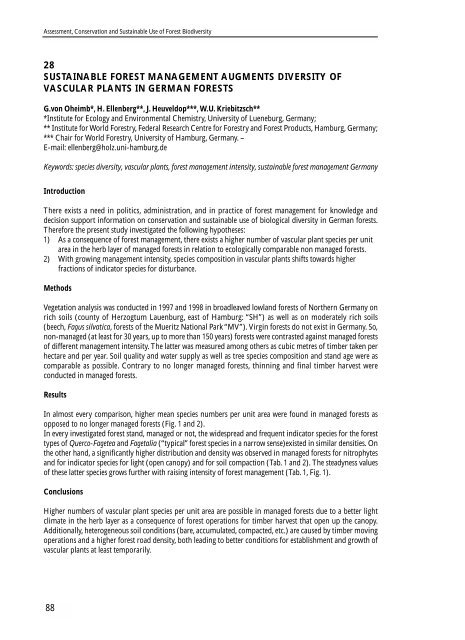Assessment, Conservation and Sustainable Use of Forest Biodiversity
Assessment, Conservation and Sustainable Use of Forest Biodiversity
Assessment, Conservation and Sustainable Use of Forest Biodiversity
Create successful ePaper yourself
Turn your PDF publications into a flip-book with our unique Google optimized e-Paper software.
<strong>Assessment</strong>, <strong>Conservation</strong> <strong>and</strong> <strong>Sustainable</strong> <strong>Use</strong> <strong>of</strong> <strong>Forest</strong> <strong>Biodiversity</strong><br />
28<br />
SUSTAINABLE FOREST MANAGEMENT AUGMENTS DIVERSITY OF<br />
VASCULAR PLANTS IN GERMAN FORESTS<br />
G.von Oheimb*, H. Ellenberg**, J. Heuveldop***, W.U. Kriebitzsch**<br />
*Institute for Ecology <strong>and</strong> Environmental Chemistry, University <strong>of</strong> Lueneburg, Germany;<br />
** Institute for World <strong>Forest</strong>ry, Federal Research Centre for <strong>Forest</strong>ry <strong>and</strong> <strong>Forest</strong> Products, Hamburg, Germany;<br />
*** Chair for World <strong>Forest</strong>ry, University <strong>of</strong> Hamburg, Germany. –<br />
E-mail: ellenberg@holz.uni-hamburg.de<br />
Keywords: species diversity, vascular plants, forest management intensity, sustainable forest management Germany<br />
Introduction<br />
There exists a need in politics, administration, <strong>and</strong> in practice <strong>of</strong> forest management for knowledge <strong>and</strong><br />
decision support information on conservation <strong>and</strong> sustainable use <strong>of</strong> biological diversity in German forests.<br />
Therefore the present study investigated the following hypotheses:<br />
1) As a consequence <strong>of</strong> forest management, there exists a higher number <strong>of</strong> vascular plant species per unit<br />
area in the herb layer <strong>of</strong> managed forests in relation to ecologically comparable non managed forests.<br />
2) With growing management intensity, species composition in vascular plants shifts towards higher<br />
fractions <strong>of</strong> indicator species for disturbance.<br />
Methods<br />
Vegetation analysis was conducted in 1997 <strong>and</strong> 1998 in broadleaved lowl<strong>and</strong> forests <strong>of</strong> Northern Germany on<br />
rich soils (county <strong>of</strong> Herzogtum Lauenburg, east <strong>of</strong> Hamburg: “SH”) as well as on moderately rich soils<br />
(beech, Fagus silvatica, forests <strong>of</strong> the Mueritz National Park “MV”). Virgin forests do not exist in Germany. So,<br />
non-managed (at least for 30 years, up to more than 150 years) forests were contrasted against managed forests<br />
<strong>of</strong> different management intensity. The latter was measured among others as cubic metres <strong>of</strong> timber taken per<br />
hectare <strong>and</strong> per year. Soil quality <strong>and</strong> water supply as well as tree species composition <strong>and</strong> st<strong>and</strong> age were as<br />
comparable as possible. Contrary to no longer managed forests, thinning <strong>and</strong> final timber harvest were<br />
conducted in managed forests.<br />
Results<br />
In almost every comparison, higher mean species numbers per unit area were found in managed forests as<br />
opposed to no longer managed forests (Fig. 1 <strong>and</strong> 2).<br />
In every investigated forest st<strong>and</strong>, managed or not, the widespread <strong>and</strong> frequent indicator species for the forest<br />
types <strong>of</strong> Querco-Fagetea <strong>and</strong> Fagetalia (“typical” forest species in a narrow sense)existed in similar densities. On<br />
the other h<strong>and</strong>, a significantly higher distribution <strong>and</strong> density was observed in managed forests for nitrophytes<br />
<strong>and</strong> for indicator species for light (open canopy) <strong>and</strong> for soil compaction (Tab. 1 <strong>and</strong> 2). The steadyness values<br />
<strong>of</strong> these latter species grows further with raising intensity <strong>of</strong> forest management (Tab. 1, Fig. 1).<br />
Conclusions<br />
Higher numbers <strong>of</strong> vascular plant species per unit area are possible in managed forests due to a better light<br />
climate in the herb layer as a consequence <strong>of</strong> forest operations for timber harvest that open up the canopy.<br />
Additionally, heterogeneous soil conditions (bare, accumulated, compacted, etc.) are caused by timber moving<br />
operations <strong>and</strong> a higher forest road density, both leading to better conditions for establishment <strong>and</strong> growth <strong>of</strong><br />
vascular plants at least temporarily.<br />
88

















